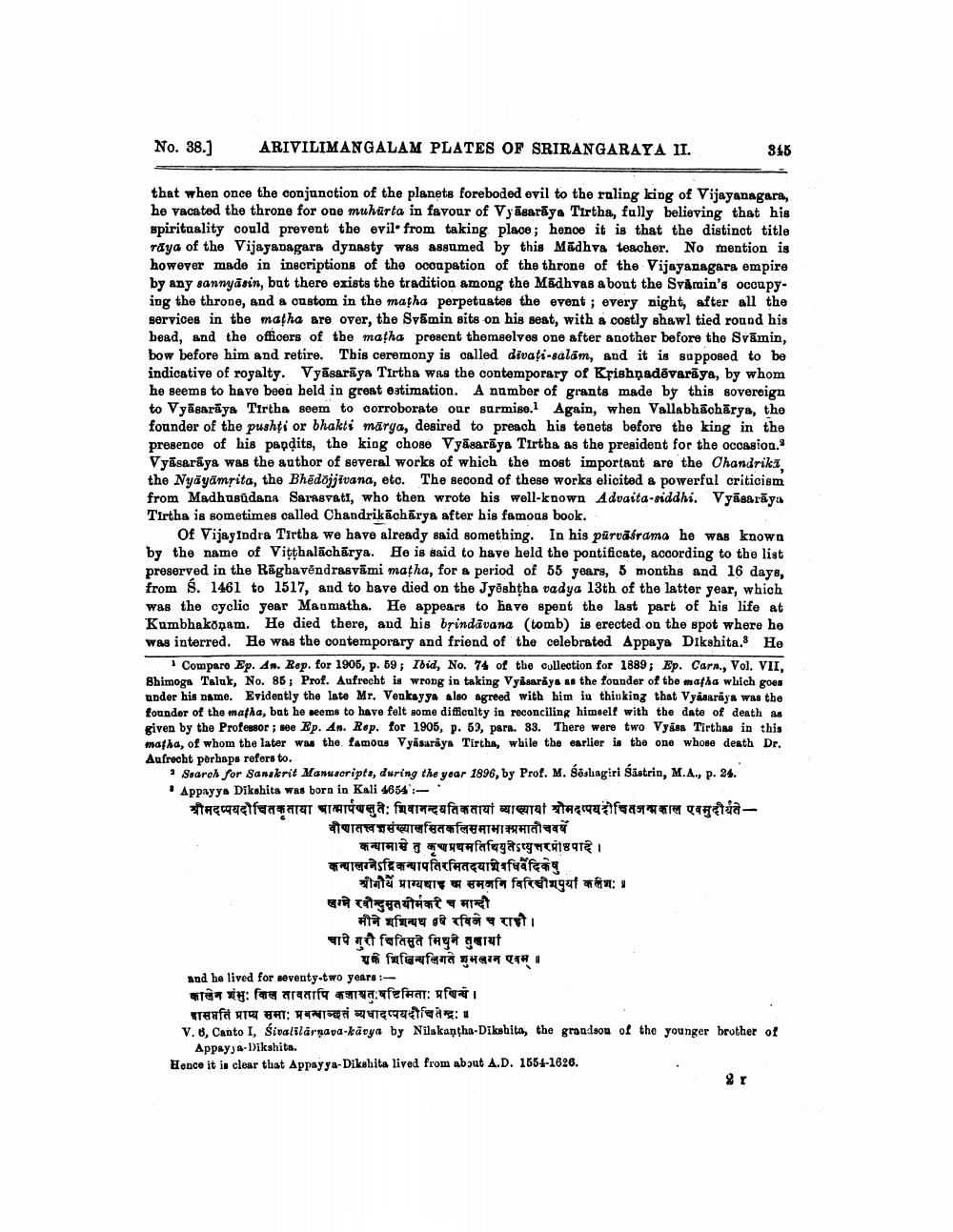________________
No. 38.]
ARIVILIMANGALAM PLATES OF SRIRANGARAYA II.
346
that when once the conjunction of the planets foreboded evil to the ruling king of Vijayanagara, he vacated the throne for one muhurta in favour of Vyāsarāya Tirtha, fully believing that his spirituality could prevent the evil. from taking place; hence it is that the distinct title raya of the Vijayanagara dynasty was assumed by this Madhva teacher. No mention is however made in inscriptions of the occupation of the throne of the Vijayanagara empire by any sannyäsin, but there exists the tradition among the Madhvas about the Svåmin's occupying the throne, and a custom in the matha perpetuates the event ; every night, after all the services in the matha are over, the Svāmin sits on his seat, with a costly shawl tied round his bead, and the officers of the matha present themselves one after another before the Svāmin, bow before him and retire. This ceremony is called divaţi-salám, and it is supposed to be indicative of royalty. Vyāsarāya Tirtha was the contemporary of Krishnadēvarāya, by whom he seems to have been held in great estimation. A number of grants made by this sovereign to Vyasaraya Tirtha seem to corroborate our surmise. Again, when Vallabhãohārya, the founder of the pushti or bhakti mārga, desired to preach his tenets before the king in the presence of his papdits, the king chose Vyasarāya Tirtha as the president for the occasion. Vyasarāya was the author of several works of which the most important are the Chandriki the Nyäyämpita, the Bhēdojjivana, etc. The second of these works elicited a powerful criticism from Madhusudana Sarasvati, who then wrote his well-known Advaita-siddhi. Vyāsarāya Tirtha is sometimes called Chandrikāchārya after his famous book.
Of Vijay Indra Tirtha we have already said something. In his pūrväsrama he was known by the name of Vitthalāchārya. He is said to have held the pontificate, according to the list preserved in the Raghavendrasvāmi matha, for a period of 55 years, 5 months and 16 days, from s. 1461 to 1517, and to have died on the Jyoshtha vadya 13th of the latter year, which was the cyclic year Manmatha. He appears to have spent the last part of his life at Kumbhakonam. He died there, and his brindāvana (tomb) is erected on the spot where he was interred. He was the contemporary and friend of the celebrated Appaya Dikshita. He
Compare Ep. 41. Rep. for 1905, p. 59; Ibid, No. 74 of the collection for 1889; Ep. Carn., Vol. VII, Shimoga Taluk, No. 86; Prof. Aufrecht is wrong in taking Vyasarāya as the founder of the matha which goes under his name. Evidently the late Mr. Venkayfa also agreed with him in thinking that Vyasarāya was the founder of the matha, but he seems to have felt some difficulty in reconciling himself with the date of death as given by the Professor ; see Ep. An. Rep. for 1905, p. 59, para. 83. There were two Vyasa Tirthas in this matha, of whom the later was the famous Vyasaraya Tirtha, while the earlier is the one whose death Dr. Aufrecht perhaps refers to.
Soarch for Sanskrit Manuscripts, during the year 1896, by Prof. M. Göshagiri Sastrin, M.A., p. 24. • Appayya Dikshita was born in Kali 4654:श्रीमदप्पयदौचितकृताया पात्मार्पणस्तुतेः शिवानन्दयतिकतायां व्याख्यायां श्रीमदापयहोषितजन्मकाल एवमुदीर्यते
वीणातत्त्वजसंख्यालसितकलिसमामाक्प्रमातीचवर्षे
TIÊ afafagasty where कन्यालग्नेऽद्रिकन्यापतिरमितदयाशेवधिवैदिकेषु
श्रीगौय प्राग्यथा सममनि विरिचौशपु कलेशः। खग्मे रवीन्दुस्तयोर्मकर च मान्दी
Ata fuay gê fortreti चापे गुरौ क्षितिसुते मिथुने तुखार्या
Ta fufafaraghava *** and he lived for seventy-two years :Fêu vy: fue araara a fefaat: ufati
Teafara ##T: 0714 24ęcaties: V.8, Canto I, Śivalilarnava-karya by Nilakantha-Dikshita, the grandsou of the younger brother of
Appayje-Dikshita. Hence it is clear that Appayya Dikshita lived from about A.D. 1654-1626.




